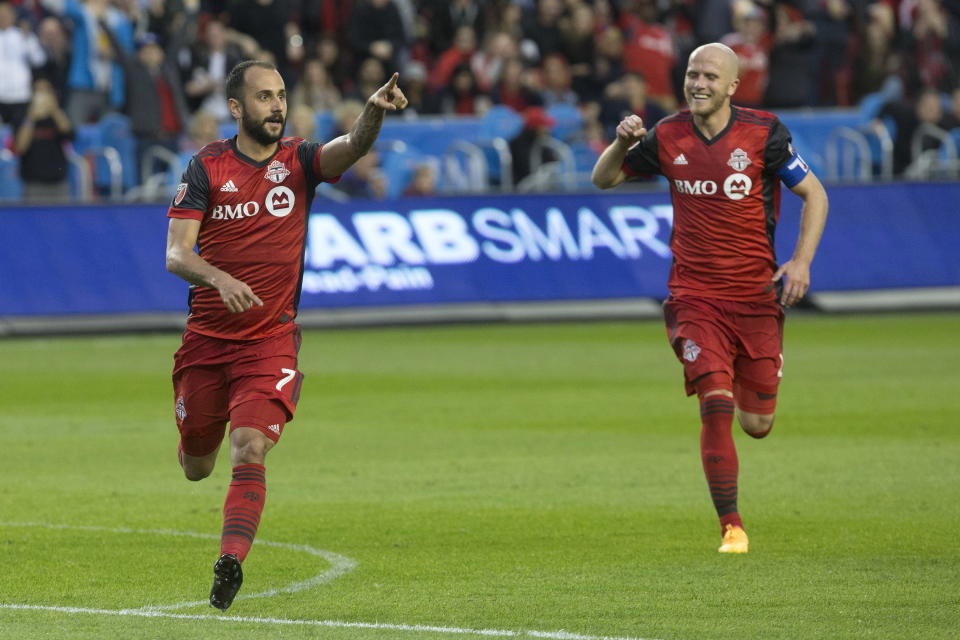Evolution of MLS only adds to balance and intrigue of the postseason

In Major League Soccer’s 22 seasons, we’ve developed a habit of defining its chronology in software terms. When David Beckham arrived in 2007 and changed everything, we began speaking of MLS 2.0. When the league evolved further, it was MLS 3.0.
In truth, if you insist on sticking with this tortured metaphor, the league is probably closer to being on edition 7.4.28 as it’s continuously worked to upgrade, update and debug its programming.
On Wednesday, its 22nd playoffs kick off. Which, if you’ll permit the tangent, is still by far the most exhilarating way of deciding a championship. Never mind that it diminishes regular season importance, or that it isn’t what most of the world does. Or even that one-off or two-legged ties favor the weaker teams given the potential for upsets. Sports aren’t inherently fair, that’s their beauty. If everything was fair, the best team would always win and the whole exercise would be pointless.
At any rate, these playoffs demonstrate the lengths the league has come — whatever the version number you want to stick on it. Because with 22 teams competing — to be 23 next year and 28 in the not-super-distant future — and only a dozen making it to the playoffs, the margin for error over the grueling 34-game regular season was greatly reduced. All the more so because only the top two teams in each conference were spared the dreaded knockout round and placed directly in the conference semifinals.
The playoff field almost universally consists of balanced teams that have integrated their star players. In the past, you might see teams that were patched together around a few expensive stars, dragging their merely mortal peers upwards — although that roster-building strategy failed more often than it succeeded. Or you’d see a team that eschewed the superstars altogether and instead opted to spread the scarce salary cap money around to create depth. The latter teams were competitive for years after the Designated Player was instituted. In fact, it took five years for a team with a DP on board to even win MLS Cup — the Galaxy in 2011, their first of three titles in four years.
Now, you have to do both. Sign the right star players for your DP slots and maximize every dollar that’s left. A gradual loosening of the league purse strings on the second and even third tier of players has helped — through Targeted Allocation Money and increased availability of funds to retain homegrown stars — has allowed for increased depth.
And you’re beginning to see, for the first time, a closer correlation between payroll and performance — the way you would in any league with an unfettered salary structure. Look at the total payrolls for 2017, and you’ll note that of the nine biggest spenders in the league, only two missed the playoffs — the Galaxy and Orlando City. Meanwhile, of the bottom seven teams, only one reached the postseason.
Until quite recently, that wasn’t usually the case.
Possibly because you no longer have to choose between signing a few stars or signing a deep team. The superstar Designated Player signing, in fact, is going away. Before the 2015 season, we saw the last big spasm of veteran stars picking up a last big payday stateside. That’s when New York City FC signed Frank Lampard, Andrea Pirlo and David Villa, while Orlando City nabbed Kaka, the Montreal Impact landed Didier Drogba and the Galaxy got Steven Gerrard. Since then, the only players to contribute to the league’s fading “retirement league” image were U.S. national team goalkeeper Tim Howard and German world-beater Bastian Schweinsteiger. And from the class of 2015, only Villa remains.
Teams are no longer top- or bottom-heavy. Those that can’t work out how to construct rosters that cut down the middle tend to struggle now. This has become a general manager’s league of sorts. The league’s savvier deal-makers — Toronto’s Tim Bezbatchenko; Chicago’s Nelson Rodriguez, after an iffy start; NYCFC’s Claudio Reyna, in spite of the aging stars foisted on him; Atlanta’s Carlos Bocanegra; Seattle’s Garth Lagerwey; Portland’s Gavin Wilkinson; Sporting KC’s Peter Vermes, who is also the coach — have thrived in recent years.
While there’s still a spending power gap of four-to-one between the top-spending team (Toronto, $20.1 million) and the cheapest one (Houston, $4.8m), 16 out of 22 teams are within a factor of two from one another in terms of the base salaries they pay out, hovering between $12.3 million and $5.4 million. As far as global soccer leagues go, you’d have a hard time finding another one where the field is packed so close together in payroll expenditure. And, consequently, few leagues are as competitive top-to-bottom. This parity may be largely artificial, but it makes for unpredictable playoffs.
Toronto FC set a regular season record for total points at 69 by compiling two six-game winning streaks, besting the Galaxy’s 68 points from 1998 — although that team got to play two fewer games and was deducted two points from ties because of lost penalty shootouts. Last season, Toronto lost the final to the Sounders on penalties. And they are favored to repeat.
But then Seattle and expansion side Atlanta both lost just twice in their last 18 league games and they both won a very healthy nine of those. The team to catch fire late in the season is often the one to lift the shiny trophy when the MLS Playoffs conclude. Just ask Seattle, which overcame a disastrous start last year, narrowly reaching the playoffs and riding several late or controversial wins to the title.
In that regard, MLS hasn’t changed a much. Even though everything else has.
Leander Schaerlaeckens is a Yahoo Sports soccer columnist and a sports communication lecturer at Marist College. Follow him on Twitter @LeanderAlphabet.



